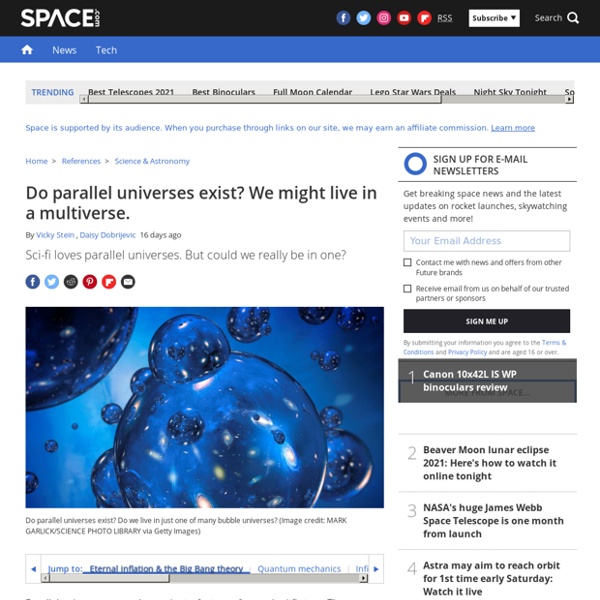Hubble identifie des étoiles "monstrueuses" 30 millions de fois plus brillantes que le Soleil
En utilisant le télescope spatial Hubble, des astronomes ont réussi à identifier neuf étoiles inconnues. Réunis dans un seul amas, ces astres sont de vrais mastodontes qui brilleraient ensemble 30 millions de fois plus que le Soleil. Avec ses 1,3 million de kilomètres de diamètre, le Soleil peut paraitre très impressionnant. Pourtant, il n'est pas grand chose face à certaines étoiles de l'Univers.
Visions of the Future
Imagination is our window into the future. At NASA/JPL we strive to be bold in advancing the edge of possibility so that someday, with the help of new generations of innovators and explorers, these visions of the future can become a reality. As you look through these images of imaginative travel destinations, remember that you can be an architect of the future. Click on any of the thumbnails below to learn more and download a free poster sized image.
The Cosmic Accident of Life: Alan Lightman on Dark Energy, the Multiverse, and Why We Exist
Questions like why our world exists and what nothing is have occupied minds great and ordinary since the dawn of humanity, and yet for all our scientific progress, they continue to do so, yielding only hypotheses rather than concrete answers. But there is something immutably heartening in the difference between the primitive hypotheses of myth, folklore and religion, which handed off such mysteries to various deities and the occasional white-bearded man, and the increasingly educated guesses of modern science. In the title essay of his excellent The Accidental Universe: The World You Thought You Knew (public library), which also gave us this beautiful meditation on science and spirituality, Alan Lightman points to fine-tuning — the notion that the basic forces propelling our universe appear to be fine-tuned in such a way as to make the existence of life possible — as a centerpiece of how modern scientists have attempted to answer these age-old questions.
Is our Milky Way galaxy a zombie, already dead and we don't know it?
Kevin Schawinski, Swiss Federal Institute of Technology Zurich Like a zombie, the Milky Way galaxy may already be dead but it still keeps going. Our galactic neighbor Andromeda almost certainly expired a few billion years ago, but only recently started showing outward signs of its demise. Galaxies seem to be able to “perish” – that is, stop turning gas into new stars – via two very different pathways, driven by very different processes.
Physicists Believe They've Discovered a Fifth Fundamental Force of the Universe
Although physics may seem complicated to the uninitiated (or even to the trained professional, for that matter), it’s worth remembering that physics deals with only four known forces: gravity (which keeps us from floating off the Earth); electromagnetism (which binds electrons to atoms, and atoms to each other); and two forces that operate over very short distances—the strong nuclear force (which binds atomic nuclei together) and the weak nuclear force (which governs certain kinds of radioactive decay). But if recent experimental work in particle physics pans out, we may have to get used to the idea of a fifth force. The research outlining the evidence for this fifth force was published last week in the journal Physical Review Letters. If the discovery holds up, it will radically shake up what we know about the workings of the universe. If the research pans out, it could be particularly helpful in at least two lines of research.
The Edge Of The Universe Is Closer Than Scientists Previously Thought
The visible universe just shrunk by 320 million light-years in all directions, updating a famous calculation that physicists first made 13 years ago. If you're trying to calculate the size of the cosmos, the speed of light — the fastest anything can go — is a tempting place to begin and end. You'd reason that since the Big Bang happened some 13.8 billion years ago, there's a 13.8-billion-light-year radius marking the edge of what mere mortals could see. Not so.
Un trou noir supermassif libère des explosions de gaz dans une galaxie voisine
Deux émissions massives de gaz provenant d'un trou noir ont été enregistrées par le télescope spatial Chandra. Selon les astronomes, ce phénomène s’apparente à une sorte de "rot" après que le trou noir se soit nourri d’étoiles. Les astronomes ont identifié deux émissions massives de gaz provenant d'un trou noir supermassif situé dans le centre d'une galaxie voisine. Les images du phénomène semblable à deux arcs et assimilé à une "régurgitation", ont été reprises par le télescope spatial à rayons X Chandra de la NASA. "A titre de comparaison, les astronomes se réfèrent souvent aux trous noirs comme des "mangeurs" d’étoiles et de gaz.
Why the multiverse is all about you - The Philosopher's Zone
In general, quantum physicists don't have much truck with big conceptual schemes. But one of their own has broken rank. Christopher Fuchs tells Joe Gelonesi how a particular school of 20th century philosophy helps him make quantum leaps. Quantum mechanics can be tough to get your head round. It's incredibly technical, theoretical, and in some part you could say philosophical.
Universe has 2 trillion galaxies, astronomers say
There are a dizzying two trillion galaxies in the universe, up to 20 times more than previously thought, astronomers reported on Thursday. The surprising finding, based on 3D modeling of images collected over 20 years by the Hubble Space Telescope, was published in the Astronomical Journal. Scientists have puzzled over how many galaxies the cosmos harbors at least since US astronomer Edwin Hubble showed in 1924 that Andromeda, a neighboring galaxy, was not part of our own Milky Way. But even in the era of modern astronomy, getting an accurate tally has proven difficult. To begin with, there is only part of the cosmos where light given off by distant objects has had time to reach Earth. The rest is effectively beyond our reach.



